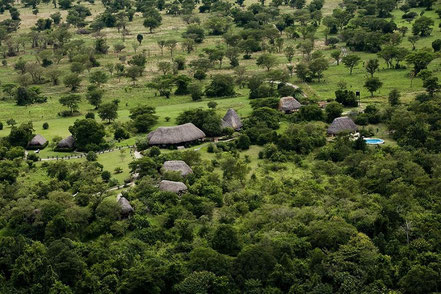what can i do at toro semuliki wildlife reserve in 2024/2025

Primate walks
The Toro Semliki wildlife reserve walk takes approximately 3 to 4 hours and is conducted within Semliki Safari Lodge, where travelers meet an experienced ranger guide. Key primate species on the Toro Semliki walk include chimpanzees, vervet monkeys, red-tailed baboons, and black and white colobus monkeys. Angulates encountered include waterbucks, bushbucks, warthogs, buffaloes, Uganda kobs, and forest elephants. click here to see mountain gorilla trekking safaris
Game drives
The Toro Semliki Wildlife Reserve offers three game drive tracks across the savannah grassland. This wildlife reserve has smaller forest and larger savannah elephants that are often seen, alongside the buffaloes, waterbucks, bushbucks, warthogs, and Uganda kob. With luck, travelers can even see leopards and elusive bush babies. Game drives in the Toro Semliki wildlife reserve can be done in the morning, afternoon, and at night. On the night game drives, travelers may come across curious nocturnal species like the white-tailed mongoose. Click here to view our recommended mountain gorilla trekking tour
Visit the Sempaya hot springs.
While Semuliki’s species have been accumulating for over 25,000 years, the Toro Semuliki wildlife reserve contains evidence of even older processes. The Sempaya hot springs bubble up from the depths to showcase the powerful subterranean forces that have been shaping the rift valley since the last 14 million years.
Nature walks
The Toro Semliki wildlife reserve takes about 3 hours, and it takes travelers through a variety of habitats ranging from riverine forest to savannah woodland. Species encountered during the nature walks include ground hornbills, baboons, buffalo, warthogs, Uganda kobs, black and white colobus, and velvet monkeys.
Community tourism
Travelers can visit The Karugutu Community Conservation Association (KCCA) is a community-owned association whose objective is to conserve education through music, dance, and drama (MDD). The Karugutu community organizes traditional dances for tourists, and they have a shop for handcrafts at the entrance of the Toro Semliki Wildlife Reserve, which they sell to different tourists. Members of the KCCA perform for tourists.
Boat ride
Boat cruises at the Toro Semliki Wildlife Reserve are done on Lake Albert, and the key attractions for birds include shoebills, blue-breasted, African Pygmy Goose, blue-cheeked bee-eaters, and blue-headed coucals.
Hike to Nyaburogo Gorge
Hiking to Nyaburogo Gorge is an ideal opportunity for birders to start right at the Reserve Headquarters. The hike to Nyaburogo Gorge is 7 km and goes via a diversity of habitats, including savanna, a forest in the gorge, and woodland. Common birds that can be seen during the hike to Nyaburogo Gorge include the arrow-marked babbler, black-headed bushrike, tropical boubal, and Luhdrers bushrike, and primates include baboons, black and white colobus, vervets, and occasionally the chimpanzees.
Wildlife in Toro Semliki
Toro-Semliki Wildlife Reserve contains the same key species as Queen Elizabeth National Park and Murchison Falls National Parks, protecting animals such as elephants, buffalo, waterbucks, Uganda kobs, warthogs, giant forest hogs, and hippopotamus. Primates such as Chimpanzees, Baboons, and Monkey species such as Vervet, Red-tailed, Black, and White Colobus.
where is the Toro Semuliki wildlife reserve
Toro Semliki Wildlife Reserve offers a dramatic rift valley perched in between the Rwenzori Mountains, the Kijura Escarpment, and the amazing Lake Albert. Toro Semliki Wildlife Reserve's dominant vegetation type is mainly open acacia-combretum woodland, grass savannah, riparian woodland alongside the main watercourses’ patches of Borassus palm forest, and extensive swamps towards Lake Albert. And semliki's four communities include
Karugutu-Kyabandara community is located in the southern part of the Semliki wildlife reserve, approximately 18 km from Toro Fort Portal town. The Bakonjo, who are primarily traditional cultivators, dominate the Karugutu-Kyabandara community. Kakonjo's most important crops are maize, beans, cassava, soy beans, bananas, and rice, which are sold in Ntoroko and Rwebisengo markets.
The Rwebisengo community is situated on the northwestern and western edges of the toro semliki wildlife Reserve within the Semliki Flats. The Rwebisengo community is made up of three distinct tribes, namely the Batuku, Bahuma, and Batoro, who were once pastoralists. The Batuku were thought to be the descendants of the Abarusula, who served in the royal army of Kabalega under King K of Bunyoro Kitara Kingdom.
The fishing village of Ntoroko is located in the southeast corner of Lake Albert, between the estuaries of the rivers Muzizi and Wasa. The Ntoroko fishing community covers approximately 4 km2, which is reserved and gazetted as a wildlife area, offering protection to wildlife species.
Kasesenge-Kyakabaseke community is situated on the eastern escarpment of the Semliki rift valley. Kasesenge-Kyakabaseke community is mainly occupied by Bakiga migrants who came to work in the tea estates in the early 1960s.
When is the best time to go to Toro Semliki Wildlife Reserve in 2024/2025?
The best time for wildlife viewing in Toro Semliki Wildlife Reserve is during the dry season of December to February and again from June to September. During these months, there is sunshine, it rarely rains, and animals always gather around predictable water points, making wildlife viewing much easier.
